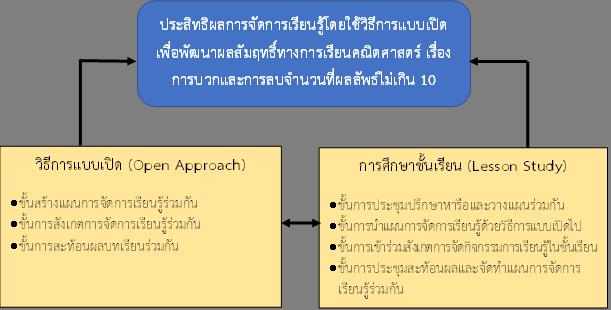Development of Learning Management Plan by Using the Open Approach, Mathematics Learning Substance, on Addition and Subtraction Amount of Solution not More than 10 for Grade 1 Students
Main Article Content
Abstract
The objectives of this research were to develop the action plan by using the Open Approach, to include the efficiency as specified Criterion 80/80, and study the effectiveness index of the action plan by the Open Approach, Mathematics Learning Substance on Addition and Subtractions the Solution not more than 10 for Grade 1 Students. The target group included 25 Grade 1 Students, Ku Kam Pittayasan School, selected by purposing sampling. The instruments using for data collection were: the action plan by using the Open Approach, and the Learning action plan. Data were analyzed by using computer program. The statistic using for data analysis included the percentage, mean, standard deviation, and dependent samples t-test. The research findings found that: For action plan by using the Open Approach, Mathematics Learning Subsisted Lesson on Division Mathematics Learning Substance on Addition and Subtraction the Solution not more than 10, its efficiency was 83.07/82.00 as the specified criterion. For effectiveness index of action plan by using the Open Approach, Mathematics Learning Achievement on Addition and Subtractions the Solution not more than 10, was 0.7128, showed that the students had higher level of learning for 71.28 %. For posttest learning achievement after studying with action plan by using the Open Approach, Mathematics Learning Substance on Addition and Subtraction the Solution not more than 10, their average score of posttest was significantly higher than the pretest at .01 level.
Article Details
References
กระทรวงศึกษาธิการ. (2560). ตัวชี้วัดและหลักสูตรแกนกลางกลุ่มสาระการเรียนรู่คณิตศาสตร์ (ฉบับปรับปรุง พ.ศ. 2560) ตามหลักสูตรแกนกลางการศึกษาขั้นพื้นฐาน พุทธศักราช 2551. กรุงเทพฯ: ชุมนุม สหกรณการเกษตรแหงประเทศไทย.
กิตติยา เกศเทศ. (2562). ผลการจัดกิจกรรมการเรียนรู้โดยใช้วิธีการแบบเปิดที่มีต่อความสามารถในการแก้ปัญหาทางคณิตศาสตร์ เรื่อง พื้นที่ผิวและปริมาตรของนักเรียนชั้นมัธยมศึกษาปีที่ 3 โรงรียนประจวบวิทยาลัย จังหวัดประจวบคีรีขันธ์. การศึกษาค้นคว้าอิสระปริญญาศึกษาศาสตรมหาบัณฑิต แขนงวิชาหลักสูตรและการสอน มหาวิทยาลัยสุโขทัยธรรมาธิราช.
จุฬาลักษณ์ เชื้อเงิน, เชวง ซ้อนบุญม และสิราวรรณ จรัสรวีวัฒน์. (2562). ผลการจัดกิจกรรมการเรียนรู้วิชาคณิตศาสตร์โดยวิธีการแบบเปิดร่วมกับการใช้คําถามของบาดแฮมที่มีต่อผลสัมฤทธิ์ทางการเรียนคณิตศาสตร์ และความสามารถในการแก้ปัญหาทางคณิตศาสตร์ของนักเรียนชั้นประถมศึกษาปีที่ 1. วารสารวิชาการ มหาวิทยาลัยราชภัฏบุรีรัมย์, 11(1), 41-58.
พัทธยากร บุสสยา, คงรัฐ นวลแปง และเวชฤทธิ์ อังกนะภัทรขจร. (2559). ผลการจัดกิจกรรมการเรียนรู้โดยใช้วิธีการแบบเปิดที่มีต่อความสามารถในการแก้ปัญหาและความคิดสร้างสรรค์ทางคณิตศาสตร์ ของนักเรียนชั้นมัธยมศึกษาปีที่ 5. วารสารศึกษาศาสตร์, 27(3), 133-146.
ภควดี วรรณโกวิท. (2563). ความรู้สึกเชิงจำนวนของนักเรียนในชั้นเรียนที่ใช้การศึกษาชั้นเรียนและวิธีการแบบเปิด. วิทยานิพนธ์ปริญญาศึกษาศาสตรมหาบัณฑิต สาขาวิชาคณิตศาสตรศึกษา คณะศึกษาศาสตร์ มหาวิทยาลัยขอนแก่น.
ไมตรี อินทร์ประสิทธิ์. (2554). การวิจัยและพัฒนานวัตกรรมเรื่องการศึกษาชั้นเรียนเพื่อการพัฒนาเครือข่ายครูคณิตศาสตร์. ขอนแก่น: คณะศึกษาศาสตร์ มหาวิทยาลัยขอนแก่น.
ไมตรี อินทรประสิทธิ์. (2557). กระบวนการแก้ปัญหาในคณิตศาสตร์ระดับโรงเรียน. ขอนแก่น: เพ็ญพรินติ้ง.
ไมตรี อินทรประสิทธิ์. (2561). พื้นฐานการจัดการเรียนการสอนคณิตศาสตร์ สำหรับศตวรรษที่ 21 ระดับมัธยมศึกษา. เอกสารประกอบการอบรมหลักสูตรเพื่อการพัฒนาครูและบุคลากรทางการศึกษาสายการสอนปี 2561. ขอนแก่น: คณะศึกษาศาสตร์ มหาวิทยาลัยขอนแก่น.
สาวิตรี ภูกองชนะ. (2562). การวิเคราะห์ความคิดรวบยอดทางคณิตศาสตร์เรื่องการลบ ของนักเรียนโดยใช้การแสดงแทนในชั้นเรียนที่ใช้การศึกษาชั้นเรียนและวิธีการแบบเปิด. วิทยานิพนธ์ปริญญาศึกษาศาสตรมหาบัณฑิต สาขาวิชาคณิตศาสตรศึกษา คณะศึกษาศาสตร์ มหาวิทยาลัยขอนแก่น.
Edmonds, W, A., and Kennedy, T, D. (2017). An Applied Guide to Research Designs: Quantitative, Qualitative, and Mixed Methods. California: Sage.
Inprasitha, M. et al. (2015). Lesson Study challenges in Mathematics Education. Singapore: World Scientific.
Isoda, M. (2015). The Science of Lesson Study in the Problem Solving Approach. In M. Inprasitha, M. Isoda, P. Wang-Iverson, & B. H. Yeap (Eds.), Lesson Study: Challenges in Mathematics Education (pp. 81-108). Singapore: World Scientific.
Levy, F., & Murnane, R. J. (2004). The New Division of Labor: How Computers are Creating the Next Job Market. Princeton and Oxford: Princeton University Press.
Takahashi, K.H. (2015). Novel genetic capacitors and potentiators for the natural genetic variation of sensory bristles and their trait specificity in Drosophila melanogaster. Mol. Ecol. 24(22): 5561--5572.


